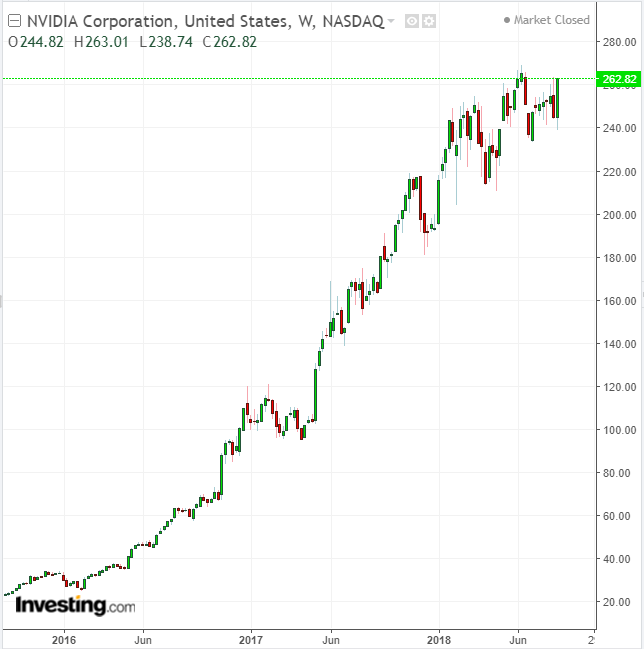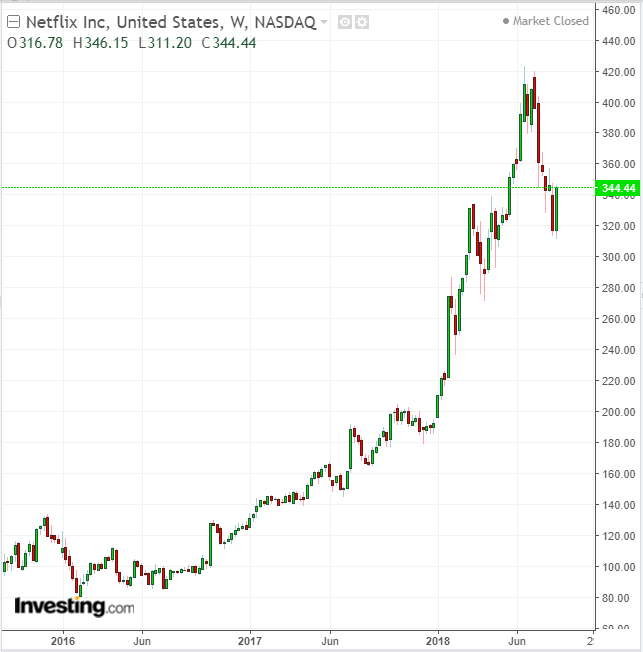For growth hungry investors, this past decade has been a bonanza, with phenomenal gains for an array of equity assets. The S&P 500 bull market, which started after the 2008 Financial Crisis, is the longest ever by some measures. It has returned almost 20% a year for 9 1/2 years, creating about $23 trillion in value for stock investors.
During this remarkable rally, some market components have delivered more astronomical gains than others. Stocks such as Nvidia (NASDAQ:NVDA) and Netflix (NASDAQ:NFLX) have been among the best performers, each producing quadruple-digit percent increases over that period.
As this bull enters its late cycle, concerns have emerged about the future growth potential of these high-flying technology names. Below, we zero in on the two mentioned above, in order to see if there's still more juice left to be squeezed.
Nvidia

The Santa Clara, California-based chipmaker sells graphics processing units (GPUs) for the gaming market. In the most recent quarter, Nvidia earned nearly 58% of its top line from this segment. The company has been benefiting from the robust market for personal computers, where graphic cards remain tightly supplied, allowing chip manufacturers to charge higher prices.
At the beginning of this year, Nvidia had about 66% of market share in discrete desktop GPUs, with competitors making up the balance. Demand for Nvidia chips has been so strong that the company is on track to double its sales this year from about $5 billion in 2016.
After a more than 1600% gain in Nvidia's stock price since early 2016, there's no sign this rally is letting up anytime soon. Indeed, since August 20, when the company unveiled a new graphics chip design for computer gamers, shares have surged about 3%. The company’s new Turing design will appear initially in three new GeForce cards.
Nvidia's growth in that market relies on its ability to persuade gamers they need the latest chip to make their experience even more realistic. With regular innovation and improvements the company has been very successful at keeping the demand momentum strong.
Beyond the gaming market, Nvidia is emerging as a major player in a number of additional segments including data center processing, autonomous vehicles, artificial intelligence and machine learning. Data center chips, for example, now account for a fifth of its revenue. It's also becoming one of the main growth drivers for Nvidia.
Netflix

The story of the world’s largest streaming video provider isn’t all that different from Nvidia's narrative. Los Gatos, California-based Netflix mounted a major challenge to traditional media companies by selling an $11-dollar streaming app to millions of subscribers globally, providing customers with a more convenient and cheaper way to watch the programs and movies they want to see, but at their own convenience.
Netflix now has over 130 million memberships in over 190 countries, offering TV series, documentaries and feature films. Members can watch as much as they want, anywhere, on any internet-connected screen, without commercials.
Currently, Netflix enjoys a complete monopoly in this space. Its closest rival Hulu, which is a joint venture between Disney (NYSE:DIS), 21st Century Fox (NASDAQ:FOX), Comcast (NASDAQ:CMCSA) and AT&T (NYSE:T), just passed the 20 million subscriber mark in May. However, it has minimal international presence compared to Netflix.
The biggest risk to Netflix, which has been the best performing S&P 500 stock this year, is that at some point its domestic subscriber growth will peak and other media giants, such as Disney, will catch up and threaten its market dominance. Netflix shares have fallen 18% since the company's second quarter report on July 16, when they announced that subscriber growth missed Wall Street estimates by nearly 1 million users.
We believe the company's global subscriber growth still has a lot of room to run, especially since Netflix has started to invest in local content to target massive markets such as India. If Netflix is successful in creating content with broad geographic and cultural appeal, it would have a huge international advantage, in particular within markets such as Japan, France, Italy, and Latin America.
Bottom Line
Though each remains a high momentum stock, neither Nvidia nor Netflix have yet hit a wall when it comes to growth. If your objective is to earn higher returns, you might consider adding these two names to your portfolio, especially now, when each has pulled back a bit from its peak.
